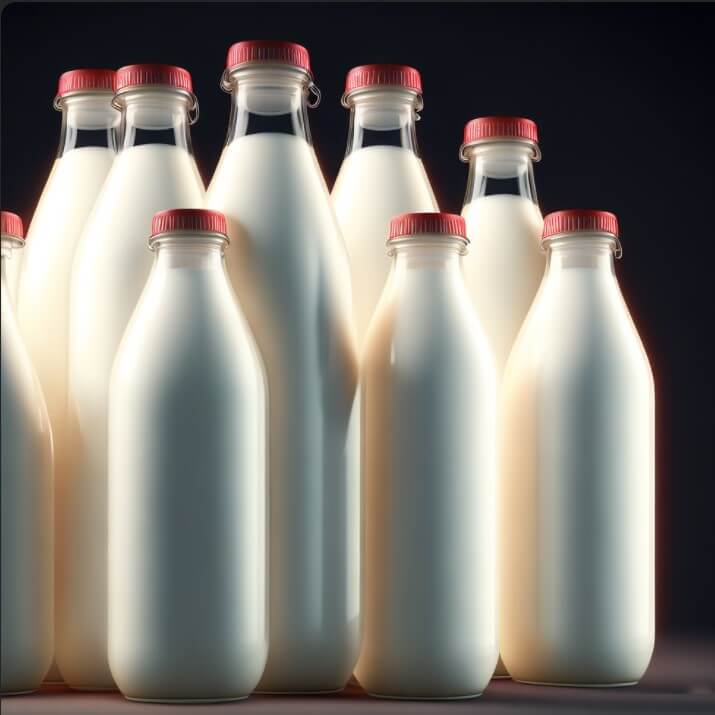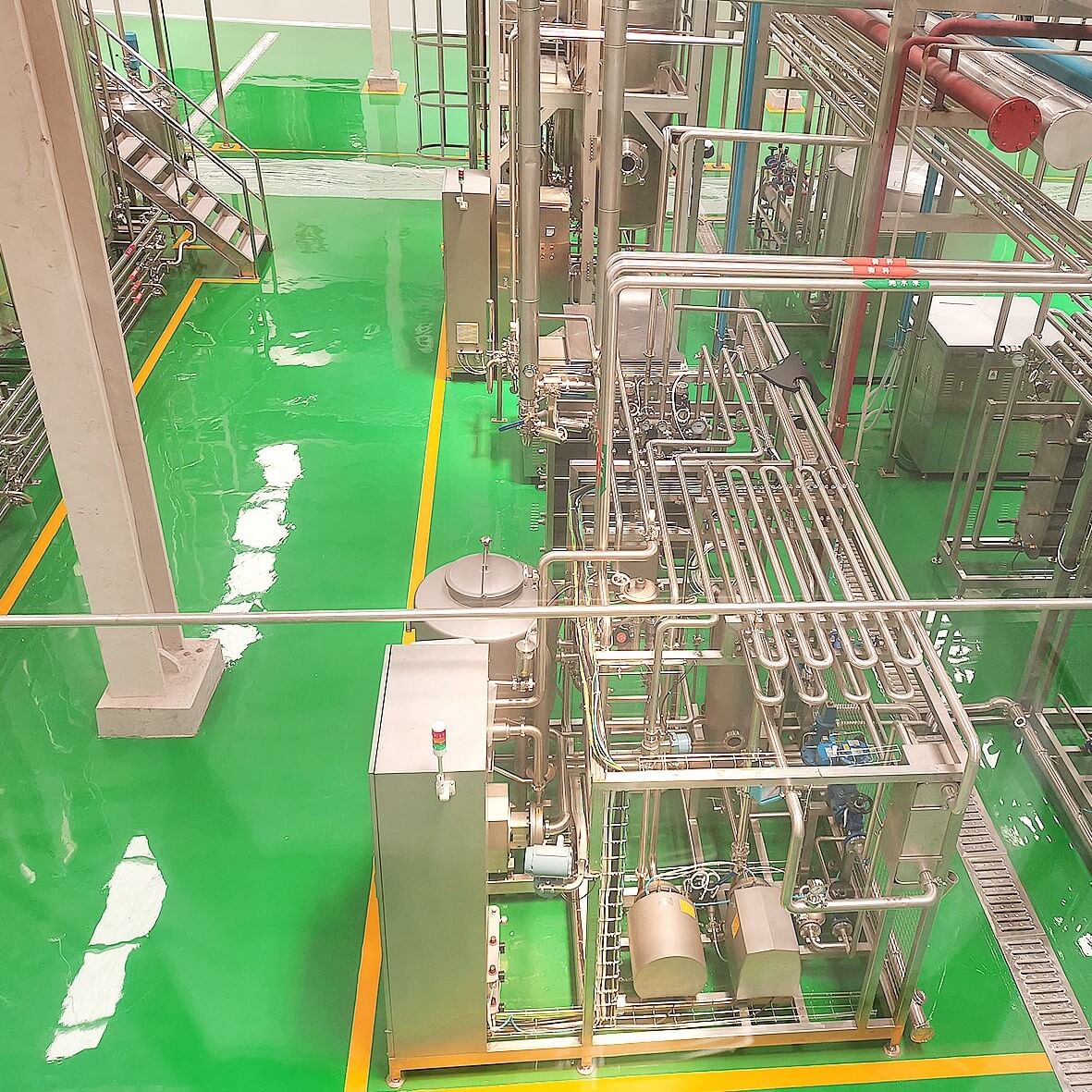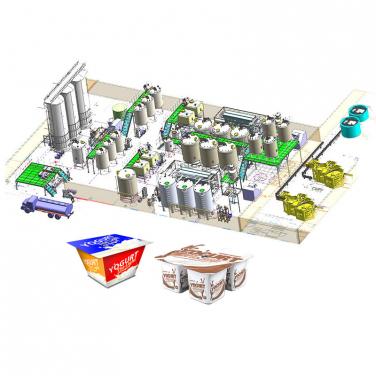
The oat milk production line is the equipment and process used to produce oat milk. The following are the main steps and equipment of a typical oat milk production line:
2. Grinding and stirring: The soaked oat grains are fed into a grinder and finely ground into oat slurry. Then mix the oat milk with water to achieve the appropriate concentration and taste.
3. Filtering and Separation: The mixed oat pulp is filtered through a filter to remove solid particles and fibers. This step can obtain a relatively pure oat liquid.
4. Sterilization and sterilization: In order to ensure the safety and shelf life of the product, oat liquid needs to undergo sterilization and sterilization treatment. Common methods include high-temperature treatment, ultra-high temperature sterilization, or sterile packaging.
5. Seasoning and additives: According to the requirements of the product, seasoning agents, sweeteners, vitamins, etc. can be added to the oat liquid. This step can increase the taste and nutritional value of the product.
6. Packaging and storage: The processed oat milk is fed into an automated packaging machine for filling, sealed, and labeled. Then store the packaged products under suitable temperature and humidity conditions to maintain their freshness and quality.
It should be noted that the specific configuration and process flow of oat milk production lines may vary depending on different manufacturers and product requirements. The above are only general production line steps, and the actual situation may vary.
The equipment of the oat milk production factory includes the following main parts:
1. Cleaning equipment: used to clean raw oats and other auxiliary materials to ensure hygiene and safety.
2. Grinding equipment: Mix oats with water and grind them into a delicate paste.
3. Filtering equipment: Filter the ground oat pulp to remove solid particles and fibers, resulting in a smoother liquid.
4. Heating equipment: Heat the filtered oat milk to kill bacteria and extend the shelf life of the product.
5. Stirring equipment: used to stir heated oat milk and mix it evenly.
6. Sterilization equipment: High temperature sterilization treatment is carried out on the heated oat milk to ensure the hygiene and safety of the product.
7. Packaging equipment: The processed oat milk can be packaged in bottles, paper boxes, or other suitable packaging forms.
8. Cleaning and disinfection equipment: used to clean and disinfect production equipment, ensuring the hygiene and safety of the production environment.
In addition, some auxiliary equipment and supporting facilities are needed, such as conveyor belts, storage tanks, metering equipment, water treatment equipment, etc., for the transportation, storage, and mixing of raw materials.
The above are common equipment in oat milk production factories, and the specific equipment configuration and scale may vary according to actual production needs.
The oat milk processing line mainly produces oat milk and related products. Here is a list of possible products:
1. Pure oat milk: This is the most basic product, a liquid made by processing and extracting oats, which can be consumed directly or used to make other foods.
2. Oat milk powder: Oat milk is processed into powder after spray drying and other processes, which is convenient for storage and use.
3. Oat milk beverage: On the basis of pure oat milk, other ingredients such as fruit juice, honey, chocolate, etc. are added to make a beverage with a richer taste.
4. Oat milk ice cream: Ice cream made from oat milk has a smooth and healthy taste.
5. Oat Milk Yogurt: By fermenting oat milk with yogurt bacteria, oat milk yogurt with probiotics can be made, which is beneficial for intestinal health.
6. Oat milk bread, biscuits and other baked goods: Using oat milk in the production of baked goods such as bread and biscuits to increase nutritional value and taste.
7. Oat milk seasoning: Oat milk is made into seasoning sauces, salad dressings, etc., to add unique flavors to other foods.
These products can be designed with different formulas and packaging forms based on market demand and consumer preferences.

The oat milk processing line is an equipment and process used to produce oat milk products. The following are the general steps for operating and maintaining an oat milk processing line:
1. Operation:
a. Preparation work: Ensure the cleanliness and hygiene of the processing line and equipment, and check if the equipment is operating properly.
b. Raw material preparation: Prepare the required oats, water, and other raw materials, and accurately weigh them according to the formula.
c. Oat Soaking: Place oats in a suitable container, add enough water, and let them soak for a period of time to soften the oats.
d. Grinding and stirring: Put the soaked oats into a grinder for grinding, and then put the ground oats and water into a mixer for stirring to make them evenly mixed.
e. Filtering and extraction: The stirred oat milk is filtered through a filter to remove solid particles and impurities, resulting in pure oat milk.
f. Sterilization and sterilization: Heat oat milk to an appropriate temperature for sterilization and sterilization treatment to ensure the hygiene and safety of the product.
g. Packaging and storage: Package the processed oat milk and store it under appropriate temperature and humidity conditions.
2. Maintenance:
a. Regular cleaning: Thoroughly clean the oat milk processing line regularly, including equipment surfaces, pipelines, filters, and other parts, to prevent contamination and cross infection.
b. Equipment inspection: Regularly check the operation status of the equipment, including the motor, transmission system, temperature control system, etc., to ensure its normal operation.
c. Component replacement: Timely replace worn or aged components to ensure the normal operation of the equipment.
d. Lubrication and maintenance: Regularly lubricate and maintain the lubrication parts of the equipment to reduce friction and wear.
e. Temperature control: Ensure that the temperature control system of the equipment is working properly and avoid the impact of high or low temperatures on product quality.
f. Storage conditions: When storing oat milk products, ensure that the temperature and humidity of the storage environment are appropriate to avoid product spoilage or moisture.
Through proper operation and maintenance, it is possible to ensure the normal operation of the oat milk processing line and produce high-quality oat milk products.

The energy consumption and environmental protection of oat milk factories are important issues. Here are some information about energy consumption and environmental protection in oat milk factories:
1. Energy consumption: The energy consumption of oat milk factories mainly comes from heating, cooling, stirring and other operations during the production process. These operations require the use of electricity or fuel, such as natural gas or fuel. Therefore, oat milk factories need to carry out reasonable management and control in energy consumption to reduce energy waste.
2. Environmental protection technology: In order to reduce energy consumption in oat milk factories and protect the environment, some environmental protection technologies can be adopted. For example, efficient heating and cooling equipment can be used to reduce energy loss. At the same time, energy-saving lamps can be introduced to optimize the lighting system and reduce electricity consumption. In addition, renewable energy sources such as solar or wind energy can also be considered to meet some energy needs.
3. Energy saving: In addition to using environmentally friendly technologies, oat milk factories can also reduce energy consumption by saving energy. For example, planning production plans reasonably to avoid excessive production and waste. At the same time, energy management policies can be formulated to encourage employees to save energy, such as turning off unnecessary equipment and lighting fixtures.
4. Waste disposal: Oat milk factories also need to pay attention to waste disposal issues. Waste disposal is crucial for environmental protection. Appropriate waste treatment technologies can be adopted, such as recycling, incineration, or landfill, to properly dispose of waste and reduce its impact on the environment.
5. Environmental monitoring and compliance: Oat milk factories should establish an environmental monitoring system to regularly monitor and evaluate the factory's environmental impact. At the same time, it is necessary to ensure compliance with relevant environmental regulations and standards to ensure that the operation of the factory is within the scope of environmental protection.
In summary, oat milk factories need to take a series of measures in terms of energy consumption and environmental protection, including the use of environmentally friendly technologies, energy conservation, waste disposal, and environmental monitoring and compliance, to reduce their impact on the environment and achieve sustainable development.
The information technology of oat milk processing line mainly includes the following aspects:
1. Automation control system: Oat milk processing lines usually use automation control systems to achieve monitoring and control of the production process. The system can monitor various links on the production line in real time through sensors and instruments, and can automatically adjust the equipment operation status based on set parameters and logical control rules, ensuring the stability and efficiency of the production process.
2. Data collection and management: Various devices and sensors in the oat milk processing line will generate a large amount of data, including real-time data of temperature, pressure, flow rate and other parameters. Information technology can be used to collect, store, process, and analyze this data. By analyzing data, abnormal situations in the production process can be detected in a timely manner, and early warning and fault diagnosis can be carried out to improve the reliability and stability of the production line.
3. Remote monitoring and operation: With the help of information technology, remote monitoring and operation of oat milk processing lines can be achieved. The equipment and systems on the production line can be connected to the upper computer or cloud platform, transmit data and instructions through the network, and achieve remote monitoring and operation. In this way, the operating status of the production line can be monitored anytime and anywhere, and operators can adjust equipment parameters and operating modes through remote operation, improving the flexibility and responsiveness of the production line.
4. Quality traceability and management: Information technology can be used to achieve quality traceability and management of oat milk processing lines. By collecting and recording data from various stages of the production process, a complete product quality traceability system can be established. Meanwhile, information technology can also be used to monitor and control key parameters in the production process, ensuring stable product quality and compliance with standard requirements.
In summary, information technology in oat milk processing lines plays an important role in improving production efficiency, optimizing production processes, and ensuring product quality. Through the application of information technology, the intelligence and digitization of production lines can be achieved, enhancing the competitiveness and market position of enterprises.
The cost of an oat milk factory refers to the various expenses and expenses required to produce oat milk. The following are some main aspects that may be included in the cost of oat milk factories:
1. Raw material cost: The main raw material for oat milk is oat, and its price will have a direct impact on factory costs. This includes the cost of purchasing oats and transportation costs related to raw materials.
2. Production equipment and facility costs: Establishing an oat milk factory requires purchasing appropriate production equipment and facilities, such as mixers, filters, filling equipment, etc. The purchase, installation, and maintenance of these equipment and facilities will increase the cost of the factory.
3. Labor cost: The factory needs to hire employees to operate production equipment, supervise production processes, and manage factory operations. Labor costs include wages, social insurance expenses, and other welfare benefits.
4. Energy cost: Producing oat milk requires energy consumption, such as electricity and gas. The cost of these energy sources will have an impact on the operating costs of the factory.
5. Packaging and labeling costs: Oat milk needs to be appropriately packaged and labeled to ensure product quality and safety. The cost of these packaging and labels is also accounted for as factory costs.
6. Marketing and sales costs: Pushing oat milk to the market requires certain marketing and sales expenses, such as advertising, promotional activities, and salaries for sales personnel.
7. Management and administrative costs: The management and administrative expenses of a factory, such as office rent, administrative staff salaries, office equipment, etc.
8. Taxes and License Costs: Operating a factory requires compliance with relevant laws and regulations, and payment of corresponding taxes and license fees.
The above are some of the main cost aspects that oat milk factories may involve, and the specific costs may vary depending on the size, production capacity, and geographical location of the factory.
Shanghai Beyond Machinery Co., Ltd
Beyond Machinery specializes in the design and manufacturing of oat milk processing plant. Please contact us now, and our professional technical engineers will customize the equipment plan for oat milk processing plant and provide a quotation. Please contact us now to obtain the latest equipment plan and quotation.



